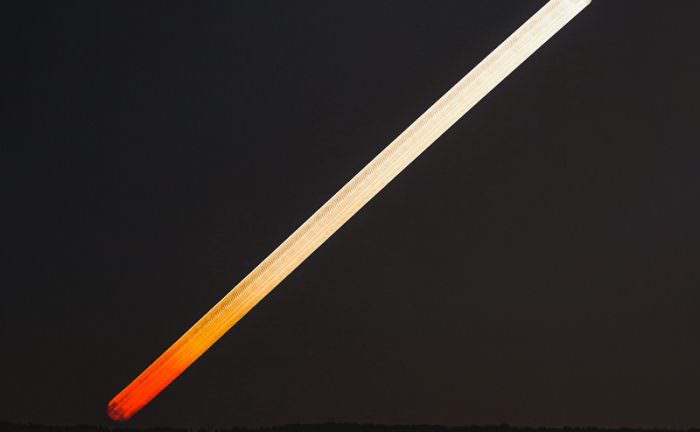Astrophotography: Stacking the Moon

Looking for something different to try in the realm of astrophotography? It’s amazing what can be done these days with the help of a little free software. DSLR cameras have gone through several generations now, and it’s often worth sitting down and exploring a new camera’s program menu just to see what intriguing settings are available.
Recently, astrophotographer Trevor Mahlmann brought the fascinating method of image stacking to our attention. Stacking allows you to simply place several sequential frames of an object such as the Moon in one image. Trevor’s recent June Full Moon rising was even featured on the prestigious Astronomy Picture of the Day (APOD) website.
As with much of astrophotography, image stacking allows us to see something unique in nature and the universe that would otherwise be invisible. Trevor describes the technique in detail on his website. Key to the method is the use of an intervalometer, which will simply allow you to shoot a series of programmed shots in succession. Some camera have these built-in, while for others, it requires a separate micro/mini USB tethered device. An intervalometer is also handy for taking automated exposures during meteor showers and time-lapses.
The motion of the Earth and the Moon becomes readily apparent in long sequence stacks.
“Your framing will also depend on what kind of Moon stack you are shooting, moonrise or moonset. At different points during the year, the Moon will rise, pass and set in different locations along the horizon.” Says Trevor.
The free program StarStaX is also crucial to the process. Another nifty App that Trevor turned us on to in the course of research is the Photographer’s Ephemeris. This shows the rising and setting azimuth for the Sun and Moon for a given location, overlaid on Google Maps. This is extremely handy if you are, say, trying to capture a moonrise shot with a recognizable landmark in the frame. We could have used this for plotting our capture of the partially eclipsed Sun behind the NASA Vehicle Assembly Building back in 2013.
Trevor Mahlmann says on his image stacking tutorial:
“The whole capture will take about 30 minutes to an hour, possibly longer if you use a shorter focal length, like 50mm or 35mm (cropped). You might check your local hourly weather forecast and take a peak at what might be coming, as it might be dark and you won’t see approaching clouds, showers or storms.” As the lunar cycle progresses, Trevor notes that “Your shutter speed and ISO values… will go down as the lunar month progresses towards Full Moon, and go back up as the month progresses towards New Moon again.”
The image stacking concept can be extended beyond the Moon as well. How about stacking successive frames of planetary images, especially during an occultation by the Moon? Or stacking successive filtered images of the Sun as it moves through the sky? Stacking is also handy on satellite shots, such as during iridium flares and passes of the International Space Station, especially at twilight and times of high contrast, when a shot demands short exposures.
What do you see in these stacked frames? Beyond just pretty pictures, stacking teases out some real effects that would otherwise remain unnoticed. One is the apparent motion of the Moon, due mostly to the rotation of the Earth. The Moon covers its own Full diameter (30′ or half a degree) about once every two minutes, and moves one degree eastward due to its own motion around the Earth every two hours. Color change is also apparent, as the Moon rises out of the thick murk of the atmosphere close to the horizon. This effect is also apparent and striking during stacked sequences taken during total lunar eclipses. Another interesting project would be to compare image stacks of the rising Moon near perigee versus apogee. The next favorable occultation of a planet by the Moon for North America under dark skies is Mars on February 18th, 2020.
And you’ll have a chance to try out this technique during next week’s Full Buck Moon coming right up on Tuesday, July 19th.
We also asked Trevor what’s next and what his thoughts are on pushing this technique a bit further.
“I am thinking of trying an all-sky moonrise to moonset photo, not sure how I would do it with the changing moon brightness, but am pondering ideas on how I would do it. I think I could get about 80% of one since even on a Full Moon, the Sun and Moon rise opposite each other and I would want to try and get color of moonrise/set on both sides. I would also need a perfectly clear night from sunset to sunrise.”
The Moon’s no longer the limit when it comes to astrophotography and image stacking.
Check out Trevor Mahlmann’s astrophotography blog.
The post Astrophotography: Stacking the Moon appeared first on Universe Today.
